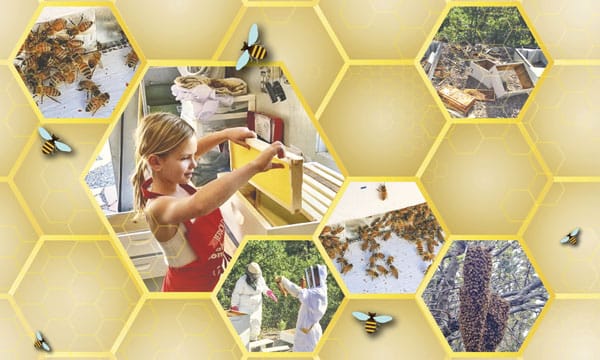Keeping busy keeping bees

Mitch McGaughey knows the vagaries of beekeeping: from bear attacks to dealing with swarms to harvesting honey. Pictured above, McGaughey’s oldest daughter, Hannah places frames in a newly-painted honey super for the bees to put honey in. Last fall, McGaughey’s Italian Bees finally produced enough honey to sell. A bear attack on the hives meant extensive repairs for McGaughey and his wife, Cathy, including placing an electric fence to keep bears from climbing into the beeyard.
By Susan Helton; photos courtesy of the McGaughey family
Happy Canyon beekeeper Mitch McGaughey is on the lookout for bee swarms. Swarming is most common in March and April because the bee population increases dramatically in the spring, creating overcrowding in the hive. So, the queen lays new queen eggs and leaves the old hive with about half of the bee workers. The swarm usually settles on a tree limb for about a day, while drone bees seek a new home. “It can be scary looking. There’s a giant ball of bees. Bees are flying everywhere. But they’re not real aggressive when they’re swarming, because they don’t have any honey to protect,” McGaughey said.
This is the time to collect the swarm to move them to a new home. To collect the bees, McGaughey takes a new hive to the site of the swarm. He cuts the limb or shakes it to drop the bees into a bag or bucket, then dumps them into the new hive. Once the queen is in the new hive, the other bees slowly join her there. McGaughey lets the hive sit there for a few hours to get all the bees, then he puts a lid on it and takes it to wherever he plans to set it up.
McGaughey has been keeping bees roughly six years. He currently has four hives, with plans to split two of them and put some hives in different locations. McGaughey got started with the hobby when he happened on some beekeeping equipment for sale. He had been interested in beekeeping and thought it might be fun, so he decided to go for it. “I had no idea how involved it was,” said McGaughey. “There’s a lot to it, a lot of tricks and stuff to learn when you’re raising the bees. But each year you do it, you get a little better at it.”
One major challenge McGaughey has encountered is bears attacking the hives. People often think that bears want the honey, but what they really want are the larvae. To get to them, bears will destroy the hives, ripping the boxes apart and pulling the frames out. They eat all the larvae off the frames and only then go to the honey.
Constructing the beeyard to deter bears is only part of the work of beekeeping. Keeping the bees alive can be challenging. Bees can be susceptible to mites and diseases, and so need to be treated for those. The hive cannot get too cold, or too warm either, and humidity levels in the hive have to be watched also. And there is the work on the hives themselves, painting and tinkering with them, building frames and getting new hives ready. Much of that work happens during the winter months. “The kids come out and help me do all that stuff. I’ve got two daughters, one’s five and one’s seven. I don’t usually get them into the beeyard with me,” McGaughey said. “When I go capture a swarm, I haven’t taken them before. But I’d love to take one of them with me and let them see all that.”
To have a bee swarm relocated, contact McGaughey at 720-463-8686.